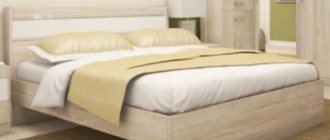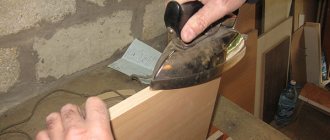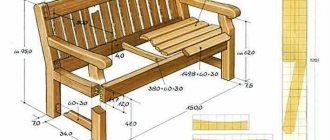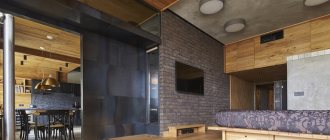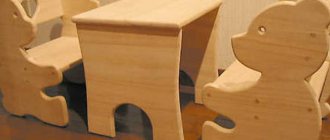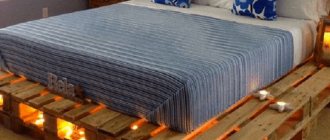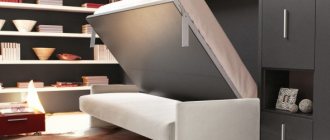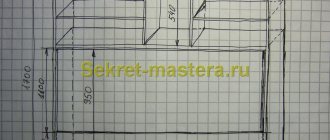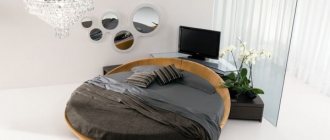What is the advantage of laminated chipboard for making a bed with your own hands?
In order to make a bed with your own hands, you can choose plywood, solid wood, and MDF. But for making at home, laminated chipboard is the best option. And that's why.
- Laminated chipboard has excellent performance characteristics
. Thanks to the manufacturing method (the slabs are produced by hot pressing of raw materials using thermosetting resins), the finished material can withstand temperature changes. Laminated chipboard has a homogeneous structure, which makes it easy to process and durable to use. - Laminated chipboard is the most budget option
. While no one can argue with the quality of beds made from solid wood, not everyone can afford such an expensive pleasure. Especially if you want to save money on it. The material is cheaper not only than solid wood, but also, for example, its closest competitor - MDF. Even if you compare ready-made options from the store, the difference is obvious: the cost of double beds made of chipboard on average starts from 100 rubles, and from solid wood - from 300 rubles. - Laminated chipboard may have additional properties
. The material can be purchased with special impregnations that will provide it, for example, with increased moisture resistance or resistance to fire, if these qualities of the material are fundamentally important to you.
The only thing you should pay attention to when choosing is the formaldehyde emission class. The fact is that the resins that are used in the production of chipboards can be harmful to health in certain quantities. Their content in slabs is regulated by standards, which are reflected in formaldehyde emission classes - they are E1 and E2. Class E1 is safe for the manufacture of any furniture, and this is what you should choose.
Material characteristics
Chipboard is a composite material in the production of which wood waste and a binder based on formaldehyde resins are used. Hot-pressed boards are much cheaper than natural wood, which is why they are often used in furniture production.
Due to the low cost of chipboard, manufacturers do not pay attention to the following disadvantages of the material:
- release of formaldehyde vapors harmful to health;
- lack of resistance to moisture, as a result of which the slab becomes deformed and quickly collapses;
- relatively low strength.
Lamination of chipboard improves its characteristics, protecting the material from dampness and the environment from harmful emissions. The protective layer, which is a melamine film or varnish coating, makes the chipboard stronger and gives the panel the appearance of more expensive wood.
Before making a bed from laminated chipboard, you need to choose the material most suitable for use in a residential area. Products belonging to the formaldehyde emission class E1 can be considered harmless to the body.
It should be taken into account that the boards have a protective coating only on 2 sides, so the ends of the chipboard need to be sealed. You can do this yourself using melamine tape, PVC or ABC edges. The invisible ends of the chipboard are painted over.
How to choose chipboard for a bed
When choosing a material for making a bed, you need to take into account two main points - embossing and thickness.
Depending on the type of embossing
slabs are designated by several letters of the Latin alphabet, for example:
- TM - the material has a matte structure;
- WML - material with the designation of natural lines of wood;
- BS - shagreen texture of the material;
- PR - laminated chipboard with indication of wood pores, etc.
For the manufacture of furniture items such as wardrobes, beds and tables, the BS and PR types are most commonly used.
Regarding the thickness
Chipboard, then it can vary from 80 to 380 mm. For the manufacture of furniture, a material with a thickness in the range from 160 to 220 mm is best suited. Here you need to take into account that the greater the thickness, the more significant the load your bed can withstand, so you should focus on the weight of the person or several people who will sleep on it.
Double bed drawing
To make a bed on your own from laminated chipboard, you need to design a competent drawing of the future product. To do this, decide in advance on the design of the bed, its size and design. Next, on a piece of paper, draw how you see the future piece of furniture. In this drawing, be sure to indicate all dimensions of parts accurate to one millimeter . Then, during the manufacturing process of individual elements and when assembling the product, you will not allow errors.
Attention: when deciding on the length of the product, take into account your height and add 20 cm to it.
When making a drawing of the product, be sure to take into account the dimensions of the mattress. It's best to purchase it in advance. This will make it easier for you to determine the exact size of the sleeping area.
Making drawings
First, let's determine the parameters of the bed itself, using standard values for each type.
Single
a bed usually measures 0.8-1.2 m by 1.9-2.2 m,
a one-and-a-half bed
is 1.2-1.6 m by 1.9-2.2 m, a
double bed
is 1.6-2 m .3 m by 2-2.2 m.
Next we move on to creating a drawing of the bed.
This is necessary so that the plan of the finished product is always before your eyes during the manufacturing process, and also in order to calculate the amount of materials needed as accurately as possible. If you don't pay enough attention to this step, this mistake can cost you dearly, and you will have to spend additional time (or even money) to make a new drawing or buy new material. To create a drawing, you need to schematically depict the bed you want to make, preferably from different angles (top and side). On the drawing you need to put down all the dimensions that you have chosen. If you are new to this business, we recommend finding several ready-made solutions on the Internet and adapting them to your size. This will make your drawing more accurate.
Next you need to do the detailing. If the drawing was a more general diagram, then here each detail is designated by a number and signed. This is necessary in order to calculate the amount of material and not forget even the smallest details.
Deciding on design and construction
Before we get to work, we need to carefully consider the drawing of a bed made of chipboard with our own hands. First of all, you should determine the dimensions. The length is not difficult to determine; you need to add 15-20 cm to the height of the person who will use the bedroom furniture. We will calculate the width based on the number of people and their physique. Married couples should consider larger sizes; children love to come to their parents' bed.
The material is selected independently, this will allow you to choose inexpensive parts.
The drawing must include space for a mattress. To make it convenient to tuck the bedroom furniture, you need to leave about one and a half centimeters on each side. Dimensions for a bed with a length of 200cm are ranked as follows:
- 80-120 single;
- 120-140 single bed;
- 140-180 double;
- 180-220 family;
- from 220 three-bedroom.
Before we get to work, we need to carefully consider the drawing of a bed made of chipboard with our own hands.
If desired, the boards can be replaced with a solid board under the mattress.
Sometimes the size of the bed is determined by the available mattress. Here we will choose a material that is 50mm larger in length and width than the mattress.
First of all, you should determine the dimensions.
Models with a lifting mechanism or drawers are often found on sale. If you want to make a bed with storage places, it is better to opt for drawers. It's easier and the material will be cheaper.
The drawing must include space for a mattress.
We will attach legs to each inner corner, under the block.
Special attention should be paid to the headboard, this is the face of the entire product. Here are some design ideas:
- Make a carving with a jigsaw, give it an unusual shape;
- apply artistic painting;
- lattice headboard;
- covered with leather with a foam insert, beautifully re-wrapped;
- sew small pillows, or several large ones;
- use decorative details.
Sometimes the size of the bed is determined by the available mattress.
If you plan to make a children's bed with your own hands, it is better to coordinate the drawings from chipboard with the child himself. This will help take into account its features, and children’s imagination can qualitatively improve the project. To make the assembly process a positive experience, you can involve the whole family in it.
If you want to make a bed with storage places, it is better to opt for drawers.
For stability, it is better to add an additional leg in the middle.
Sawing
After purchasing laminated chipboard to make a bed, it is cut. There are two solutions here - you do it yourself or turn to professionals who do it for you.
It is worth doing this yourself, unless you already have such experience, since the cost of error here is very high. You can ruin the material (more than once), and then buy a new one and try again. But if you are confident in your abilities, then for home cutting you can use a jigsaw, jigsaw or circular saw. Mark the material with a pencil and carefully saw the parts. But you need to take into account that when cutting yourself, there is a very high probability of getting chips that will ruin the entire appearance of the product.
The only guaranteed way to avoid chipping is to turn to professionals who use sawing machines to cut furniture. In addition, this method ensures the production of parts according to your drawing with millimeter accuracy, and they can be used immediately without any additional processing.
It's up to you to decide, but remember that cutting it yourself most often costs much more than turning to professionals due to the fact that you have to redo the work and spend money on buying material.
In addition, the fact that for further use the bed parts need to be treated with a plastic edge also plays in favor of turning to professionals. But you can’t do this kind of processing at home, because it requires a professional pasting line, like that of specialists from specialized companies.
How to make a bed from chipboard with your own hands
The sleeping place is a rather large specimen. At the same time, it is quite possible to assemble it. Especially if you already have skills in making sofas or cabinets. If they are not there, then do not despair. Drawings taken from the Internet will help in the process.
The main thing is to find time to design a drawing and assemble the bed.
The most expensive part of the product is the mattress. It is best to buy it ready-made, without saving on cost. After all, it depends on him how good the sleep will be. Considering that you still have to purchase furniture yourself, what prevents you from making it from your own parts.
Before we get to work, we need to carefully consider the design of a bed made of chipboard with our own hands.
Design selection
Before you start purchasing material, you need to decide on the appearance and design of the bed. According to qualifications, it is divided into one-and-a-half, single and double. The support can be directly from the headboard or backrest. The device is installed on legs or a frame. In addition, there are models with special additional drawers designed for storing bed linen, two-tiered or with an original shape.
The length is not difficult to determine; you need to add 15-20 cm to the height of the person who will use the bedroom furniture.
The product can be easily shortened or lengthened based on the height of the person for whom it is made. External parameters are selected relative to the area of the room. Most often, installation occurs close to the wall so that access to the passage remains.
Married couples should consider larger sizes; children love to come to their parents' bed.
The dimensions of the device depend on the parameters of the mattress:
- the most optimal width for a child is sixty centimeters, for an adult – eighty;
- the length of the mattress should be fifteen centimeters greater than the person’s height;
- the thickness is based on the total mass of people sleeping on it.
To make it convenient to tuck the bedroom furniture, you need to leave about one and a half centimeters on each side.
People whose height is two meters or more must order a mattress. The option of making a bed yourself significantly saves the family budget. The mattress should fit tightly into the structure, with a gap of half a centimeter should be left on each side for comfortable tucking of linen.
Sometimes the size of the bed is determined by the available mattress. Here we will choose a material that is 50mm larger in length and width than the mattress.
Necessary materials
You can actually do the drawing yourself. A standard diagram from the Internet will be an excellent basis. An option that has already been made by someone is also suitable, in which it is enough to put down your measurements.
The main part of the furniture will be made primarily from chipboard. This is an inexpensive and durable particle board.
To make a simple standard stock, you will need the following materials:
- For the front parts, laminated chipboard sheets from sixteen to twenty-five millimeters thick - legs, sides, back. The headboard is the highest part; it can be figured or in the form of a standard rectangle. The side parts must be completely identical in size. The footboard is usually the same height or slightly higher.
- Boards twenty millimeters thick - for crossbars in the amount of three pieces, intended for a mattress with a frame.
- Plywood sheet - for the bottom on which the mattress is placed.
- Timber with parameters thirty by thirty - the manufacture of a frame frame to which the bottom, transverse (three pieces) and longitudinal (two pieces) parts are fixed.
I recommend performing the assembly using Euro screws with plugs, the color of which is identical to the chipboard. This option is the most reliable and durable.
To find out how thick the material will be, you need to start from the total weight acting on the bed.
Required Tools
If the product will rest on the body and not have legs, then it is recommended to install plastic legs closer to the back, the height of which can be adjusted. With their help, the sleeping place can be set in the correct horizontal position, especially if there is an uneven floor. In addition, they will provide excellent protection against mechanical damage (for example, scratches).
To make the assembly process a positive experience, you can involve the whole family in it.
Tools you will need:
- jigsaw;
- drill with various drill bits;
- hacksaw;
- other based on the characteristics of the device.
Double furniture thrust bearings, three pieces for each support that is in contact with the floor, will be useful.
Most of the required tools and materials are usually already present in every man’s home.
Manufacturing process
The first step is to process the edge of the material and cut it. It is better to entrust these processes to professionals and order them from production. If a person decides to do everything completely on his own, then he will need an iron and a melamine edge.
You can provide a drawing of a bed made of chipboard, the dimensions of the part and the material itself to specialists, they will make cutting and edging quickly and efficiently.
The iron should be turned on at about three-quarters of its power, the edge should be applied to the open cut, and ironed. If the edges protrude beyond the slab, then the excess is cut off using a construction knife. Next, the parts are marked, laid out, holes are drilled for Euro screws, and the thrust bearings or legs are fixed.
Assembling a standard bed with a bottom consists of the following steps:
- Assemble a frame from timber; three transverse ones are used to fasten two longitudinal ones.
- Cover the resulting device with fiberboard on top.
- Attach the laminated chipboard side panels to the longitudinal beams.
- Secure the headboard and backrests to the sides (fixation should be done in two places, a distance of about three centimeters from the bottom and top edges).
Place a lattice of slats along the entire length on the bars and support beam, maintaining equal intervals.
The quantity depends on the width of the slats and spaces. If the bed does not have a bottom, but there is a frame mattress, then the assembly sequence changes slightly:
- Between the sides, fasten two transverse ones as close to the edges as possible and one in the center. They should be located on a wide surface, perpendicular to the floor. Fixation occurs in two places.
- Attach the footboard and headboard to the sides.
This design is perfect for an ordinary mattress if you place the lattice mattress pad on supports. It can be easily found in a store if the stock has standard parameters.
If desired, the boards can be replaced with a solid board under the mattress.
The height to which the mattress rises from the floor can be adjusted as desired. The depth should be sufficient so that it is fixed as tightly as possible. Also, the mattress should be slightly higher than the sides of the bed.
Bed decor
As decoration for the product, you can use MDF overlays in contrasting shades, each thickness is approximately ten millimeters. They should be secured to the headboard itself, as well as to the footboard. The size of the decoration is sixteen centimeters smaller than the parameters of the footboard. The space between the elements is eight centimeters from each side. Fixation occurs with the help of screws, their length is only a couple of millimeters less than the total thickness of MDF and chipboard.
That's all, a do-it-yourself chipboard bed is ready, without any special difficulties.
The overlays can also be made of plywood, covered with thin foam rubber or fabric. They must be fastened immediately before assembling the structure.
Assembly of the finished product
When you have ready-made parts and accessories on hand, you can proceed directly to assembly, having previously prepared all the necessary tools.
- First, we assemble the bed frame, that is, we connect the side walls with the headboard and footboard using a screwdriver. For added strength, you can use metal corners. As a result, we should get a rectangular box.
- Next, we secure the transverse and longitudinal crossbars, checking the geometry of the product using a level.
- We attach the base for the flooring to the side walls.
- We attach the mattress base to the decking base. It can be either lattice, or plywood, or chipboard.
- We remove any debris remaining after assembly and place the mattress on the finished bed.
Features of laminated chipboard
Laminated chipboard is made from natural wood. Essentially, this is the same chipboard, only well sanded and with a durable film on the surface. The advantages of laminated chipboard include :
high resistance to high humidity;- long service life;
- wide range of colors;
- variety of textures and textures.
This material pleases consumers with interesting colors and textures . It can be:
- geometric patterns;
- plain slabs;
- various ornaments;
- imitation of any type of wood.
Reference : Laminated chipboard does not emit toxins, is resistant to mechanical damage, and is easy to process.
This material is indispensable in the manufacture of various furniture items . This is explained by the fact that this material has high technical characteristics and an affordable cost. Even if you are new to making furniture with your own hands, having clear instructions and a drawing of the product at hand, you can make a bed on your own in a fairly short time.
Having decided to make your own bedroom furniture, you can be sure that:
- you will have the opportunity to make a piece of furniture of the size and design you require;
- the item you make according to your personal sketches will be one of a kind;
- You will be able to independently select both manufacturing materials and guides and fittings. Thus, you can make both an economical version of the bed and a product with unique design features;
- In addition, you will save a lot of money, and as a result, you will have a high-quality and durable bed.
DIY bed with laminated chipboard drawers
By ordering cutting of purchased laminated chipboard sheets, you can assemble an original bed with drawers in just a few hours. To do this, you will need edging tape (if the edges were not processed when cutting, you will have to do it yourself), self-tapping screws, steel angles, a drill and fittings for drawers.
In the proposed design, the bed will have no legs at all, resting on the floor with the entire area of the laminated chipboard sheet (suitable only for a perfectly flat base). The functions of the stiffening ribs and at the same time the frame for the top slab will also be performed by chipboard strips. The ribs will not be visible, so you can use regular sanded chipboard sheets for them, this will allow you to save a little on building materials.
Bed frame with drawers made of chipboard
For the sides and bottom of the drawers, you can use multi-layer plywood or the same laminated chipboard sheets
In the proposed design, the main attention is paid to the rigidity of the assembled structure, therefore the entire space under the top sheet of chipboard is divided into 6 segments, in each of which a box can be installed
To install it, just attach the guides to the walls of the bed frame and the outer part of the drawer walls. As for the size of the box, it should be smaller than the opening for it by about 1.5 - 2 cm on each side. Then the gap will be masked with a decorative cover, which is attached to the outside of the box.
Classic bed drawing
A step-by-step guide with drawings on how to make a classic wooden bed with your own hands. The basic tools you will need are a miter saw and a jigsaw. To make a bed, you mainly use 2 x 6 boards and 4 x 4 lumber. Also, do not forget to prepare wood filler and stain. You can read the full list of necessary materials and tools on the website. Below is the cutting of the bed parts according to the diagram in the picture on the right.
A – 2 pieces of 4×4, 52 inches (132 cm) long, 2 pieces. 15 1/2″ long (36.5 cm)B – 4 1×6 boards C – 13 2×6 boards 36 1/2″ (93 cm) long D – 2 2×4 lumber – 78 1/2″ long (200 cm), 1 2×6 boards 80 1/2″ (205 cm) long E – 2 2×10 boards 80 1/2″ (205 cm) long, 1 piece – 71 1/2″ (182 cm) , 1 2 × 6 board 71 1/2" (182 cm) long side rails F – 3 2 × 4 boards 80 1/2" (205 cm) long, 14 1 × 4 boards 76 1/2" (195 cm) long auxiliary strips
Photo source: howtospecialist.com/finishes/furniture/farmhouse-bed-plans/#more-12846
Drawing of a classic wooden bed
An example with drawings on how to make a classic wooden bed with your own hands.
See diagrams and several step-by-step assembly photos in the gallery below.
Photo source: www.instructables.com/id/Custom-Bed-Frame/
Drawing of a simple wooden bed
Using this example, you can make a simple wooden bed with your own hands.
A few assembly points
Note that the slats rest on the lip on the inside of the side rails. When assembling the headboard, dowel holes are best drilled by clamping the headboard and drilling the hole all the way to the outside, as shown in the diagram
The footrest is almost identical to the headboard. If you prefer to place your feet at the end of the bed, move away from the top horizontal part and make the posts only 45cm long.
The bed rails have a series of blocks on the inside corners. The goal is to spread the slats and prevent them from slipping.
It is best to glue and screw the 38 x 38mm slat support onto the main part of the track to ensure it is securely attached. Bed frames in general are designed to be disassembled and moved. For this frame you just need to unscrew the side guides. The slats are located between the bed rails and are held in place only by gravity. Blocks on the bed rails prevent them from sliding. See drawings and diagrams with step-by-step photos in the gallery below.
Photo source: woodgears.ca/reader/richard/beds.html
